|
|
|
|
|
|
|
|
|
|
|
|
|
|
|
|
|
|
In-person events are back! As we transition back to “normal” there are several local events and celebrations for the whole family to enjoy this 4th of July! Some cities were not able to pull off such large events given the timing of opening and the circumstances surrounding the pandemic, but there are some great options in both Snohomish and King counties! Check it out:
Edmonds
https://edmondschamber.com/community_events/main_events/an_edmonds_kind_of_fourth/
An “Edmonds Kind of 4th” is back!
– Beat Brackett 5k race (registrations online only)
– Main Street parade
– Fireworks at Civic Field
Everett
https://www.visiteverett.com/1440/Fourth-of-July
Everett’s iconic Thunder on the Bay fireworks show returns to Legion Memorial Park.
Also, Everett’s first in-person concert since COVID: Rock the Fourth @ Boxcar Park (21+) featuring: Nite Wave, Petty Thief & Road Trip.
Marysville
https://marysvillewa.gov/1009/Marysville-4th-of-July
Marysville’s third annual celebration will feature festive photo opportunities, food trucks and fireworks.
Monroe
https://evergreenspeedway.com/events/july-4th-2021-usa-birthday-bash-at-evergreen/
Rain or shine, Monroe’s USA Birthday Bash will feature a Demo Derby and Fireworks!
Bellevue
https://www.bellevuedowntown.com/events/family-4th
Bellevue Family 4th will look a little different this year. There will not be any entertainment or other activities, but there will be a live firework show downtown.
Tacoma
Tacoma’s Freedom Fair & Air Show will feature military and classic planes. It is a drive-in only event, so check the website for parking spot reservations.
Seattle
Seattle Seafair is NOT hosting an in-person Fourth of July fireworks show this year. The majority of the Seattle Seafair headline events will be virtual for the second year in a row. Despite the lifting of restrictions, there was not enough time to produce these very large events. More info: Hybrid Seafair Summer 4th 2021
However, instead of the traditional Fourth of July Fireworks show over Lake Union, Seafair will produce an hour-long TV special featuring past fireworks shows. The show will air on KING 5 at 10 p.m. More info: Seafair’s Fourth of July fireworks in Seattle, hydroplane races to be virtual | king5.com
|
|
|
|
|
|
|
|
|
Q1 2021 signified a measurable shift in the real estate market. Demand since the first of the year has been brisk, proving Q1 2021 to be one of the most impactful times in market history! Interest rates remain historically low, helping to offset the cost of price appreciation. Rates and the lucrative tech-influenced job market have helped pending sales outpace new listings.
Additionally, the convergence of Millennials, Gen Xers, and Baby Boomers making big lifestyle moves du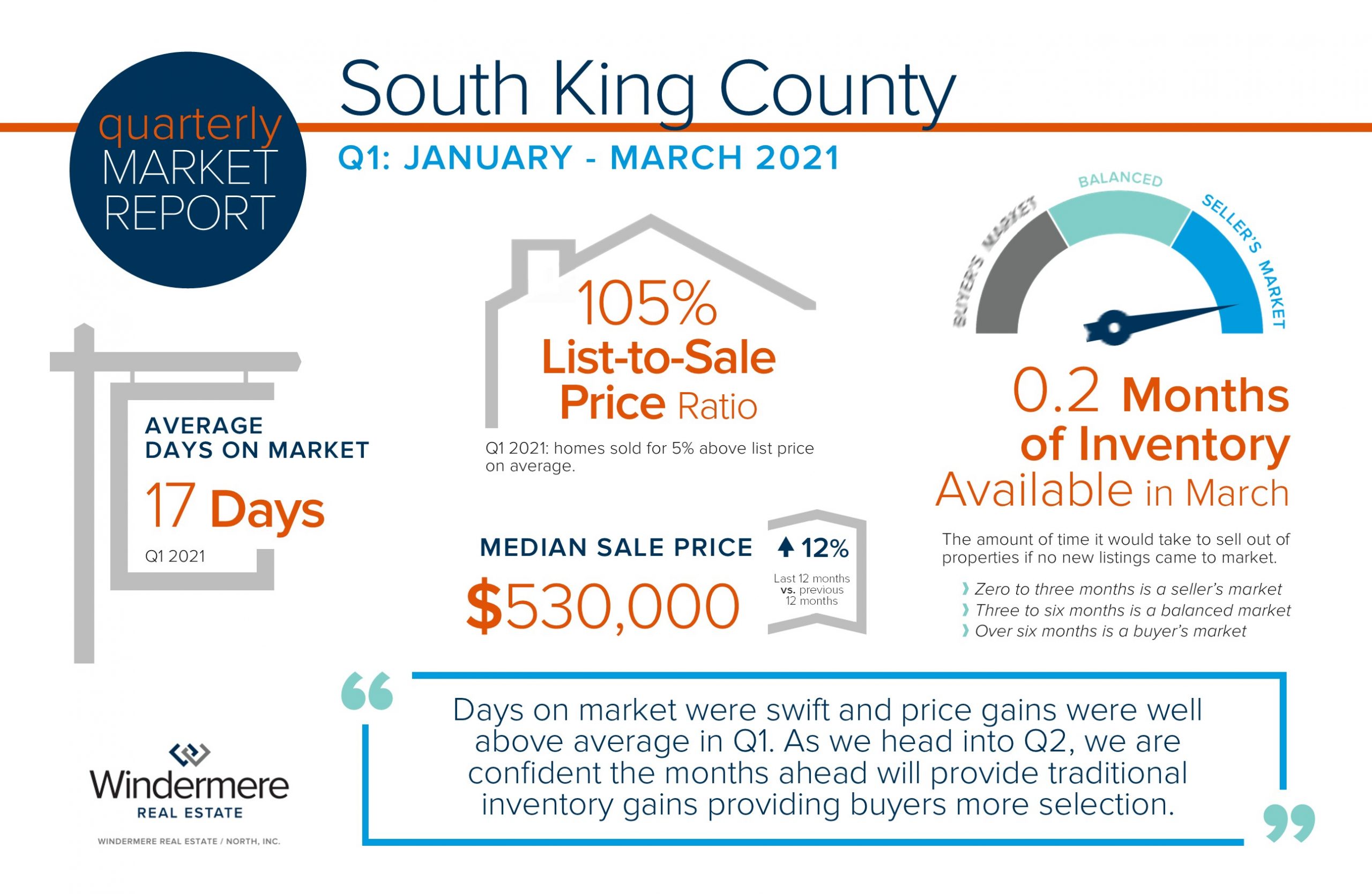 e to the low cost of debt service, work-from-home options, and formidable equity has the market frothy. Nationally, 30% of all homeowners have over 50% equity in their home, leading people to make moves with large down payments.
e to the low cost of debt service, work-from-home options, and formidable equity has the market frothy. Nationally, 30% of all homeowners have over 50% equity in their home, leading people to make moves with large down payments.
Days on market were swift and price gains were well above average in Q1. As we head into Q2, we are confident the months ahead will provide traditional inventory gains providing buyers more selection. We would welcome a tempering in price growth as it has been abundant and is affecting affordability. If you or someone you know is curious about how today’s real estate market relates to your financial and lifestyle goals, please reach out. It is my mission to help keep my clients informed and empower strong decisions.
Q1 2021 signified a measurable shift in the real estate market. Demand since the first of the year has been brisk, proving Q1 2021 to be one of the most impactful times in market history! Interest rates remain historically low, helping to offset the cost of price appreciation. Rates and the lucrative tech-influenced job market have helped pending sales outpace new listings.
Additionally, the convergence of Millennials, Gen Xers, and Baby Boomers making big lifestyle mo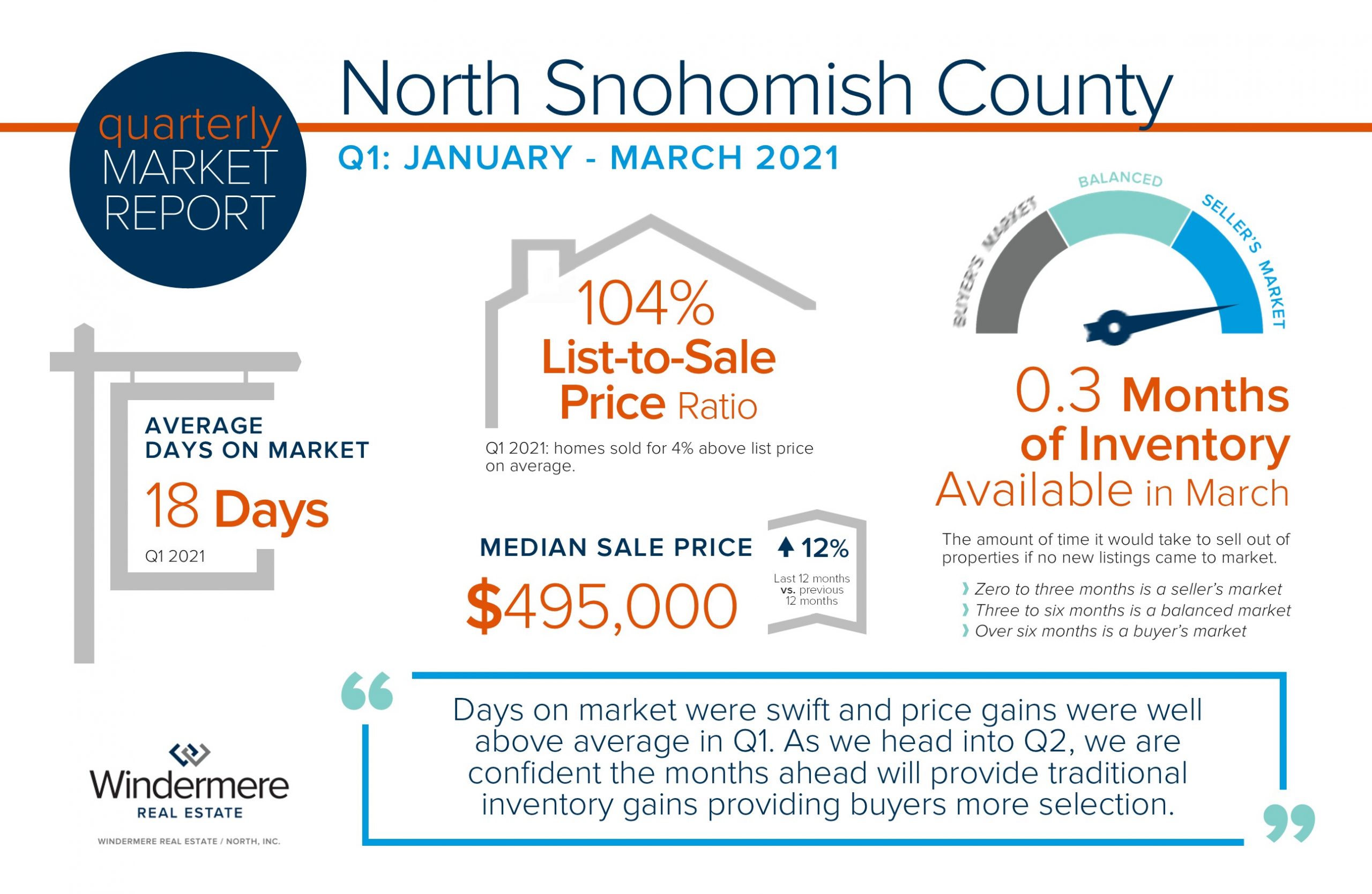 ves due to the low cost of debt service, work-from-home options, and formidable equity has the market frothy. Nationally, 30% of all homeowners have over 50% equity in their home, leading people to make moves with large down payments.
ves due to the low cost of debt service, work-from-home options, and formidable equity has the market frothy. Nationally, 30% of all homeowners have over 50% equity in their home, leading people to make moves with large down payments.
Days on market were swift and price gains were well above average in Q1. As we head into Q2, we are confident the months ahead will provide traditional inventory gains providing buyers more selection. We would welcome a tempering in price growth as it has been abundant and is affecting affordability. If you or someone you know is curious about how today’s real estate market relates to your financial and lifestyle goals, please reach out. It is my mission to help keep my clients informed and empower strong decisions.
Q1 2021 signified a measurable shift in the real estate market. Demand since the first of the year has been brisk, proving Q1 2021 to be one of the most impactful times in market history! Interest rates remain historically low, helping to offset the cost of price appreciation. Rates and the lucrative tech-influenced job market have helped pending sales outpace new listings.
Additionally, the convergence of Millennials, Gen Xers, and Baby Boomers making big lifestyle moves due to the low cost of debt service, work-from-home options, and formidable equity has the market frothy. Nationally, 30% of all homeowners 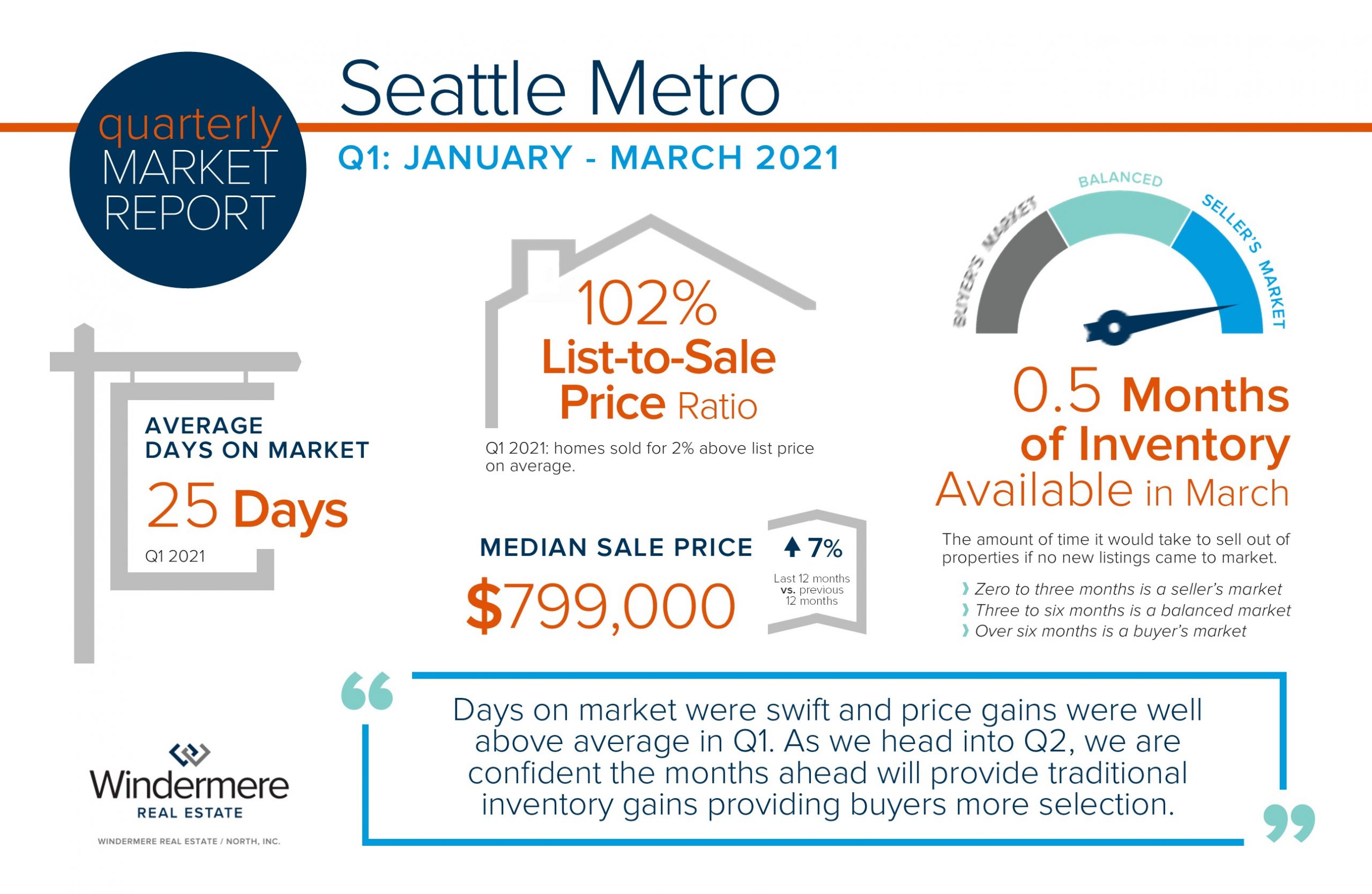 have over 50% equity in their home, leading people to make moves with large down payments.
have over 50% equity in their home, leading people to make moves with large down payments.
Days on market were swift and price gains were well above average in Q1. As we head into Q2, we are confident the months ahead will provide traditional inventory gains providing buyers more selection. We would welcome a tempering in price growth as it has been abundant and is affecting affordability. If you or someone you know is curious about how today’s real estate market relates to your financial and lifestyle goals, please reach out. It is my mission to help keep my clients informed and empower strong decisions.
Q1 2021 signified a measurable shift in the real estate market. Demand since the first of the year has been brisk, proving Q1 2021 to be one of the most impactful times in market history! Interest rates remain historically low, helping to offset the cost of price appreciation. Rates and the lucrative tech-influenced job market have helped pending sales outpace new listings.
Additionally, the convergence of Millennials, Gen Xers, and Baby Boomers making big lifestyl e moves due to the low cost of debt service, work-from-home options, and formidable equity has the market frothy. Nationally, 30% of all homeowners have over 50% equity in their home, leading people to make moves with large down payments.
e moves due to the low cost of debt service, work-from-home options, and formidable equity has the market frothy. Nationally, 30% of all homeowners have over 50% equity in their home, leading people to make moves with large down payments.
Days on market were swift and price gains were well above average in Q1. As we head into Q2, we are confident the months ahead will provide traditional inventory gains providing buyers more selection. We would welcome a tempering in price growth as it has been abundant and is affecting affordability. If you or someone you know is curious about how today’s real estate market relates to your financial and lifestyle goals, please reach out. It is my mission to help keep my clients informed and empower strong decisions.
Q1 2021 signified a measurable shift in the real estate market. Demand since the first of the year has been brisk, proving Q1 2021 to be one of the most impactful times in market history! Interest rates remain historically low, helping to offset the cost of price appreciation. Rates and the lucrative tech-influenced job market have helped pending sales outpace new listings.
Additionally, the convergence of Millennials, Gen Xers, and Baby Boomers making big lifestyle moves due to the low cost of debt service, work-from-home options, and formidable equity has the market frothy. Nationally, 30% of all homeowners have over 50% equity in their home, leading people to make moves with large down payments.
due to the low cost of debt service, work-from-home options, and formidable equity has the market frothy. Nationally, 30% of all homeowners have over 50% equity in their home, leading people to make moves with large down payments.
Days on market were swift and price gains were well above average in Q1. As we head into Q2, we are confident the months ahead will provide traditional inventory gains providing buyers more selection. We would welcome a tempering in price growth as it has been abundant and is affecting affordability. If you or someone you know is curious about how today’s real estate market relates to your financial and lifestyle goals, please reach out. It is my mission to help keep my clients informed and empower strong decisions.
Q1 2021 signified a measurable shift in the real estate market. Demand since the first of the year has been brisk, proving Q1 2021 to be one of the most impactful times in market history! Interest rates remain historically low, helping to offset the cost of price appreciation. Rates and the lucrative tech-influenced job market have helped pending sales outpace new listings.
Additionally, the convergence of Millennials, Gen Xers, and Baby Boomers making big lifestyle moves 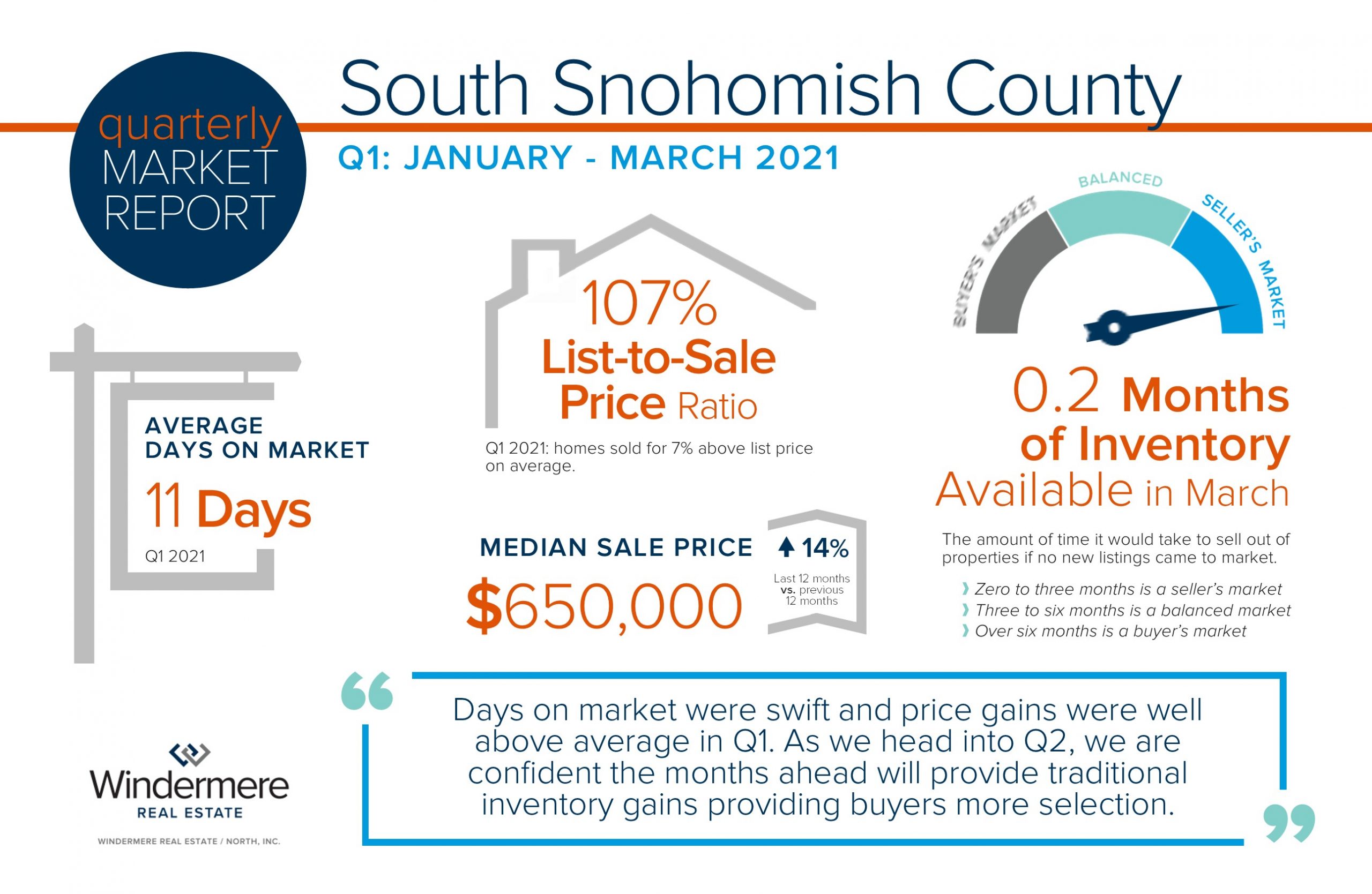 due to the low cost of debt service, work-from-home options, and formidable equity has the market frothy. Nationally, 30% of all homeowners have over 50% equity in their home, leading people to make moves with large down payments.
due to the low cost of debt service, work-from-home options, and formidable equity has the market frothy. Nationally, 30% of all homeowners have over 50% equity in their home, leading people to make moves with large down payments.
Days on market were swift and price gains were well above average in Q1. As we head into Q2, we are confident the months ahead will provide traditional inventory gains providing buyers more selection. We would welcome a tempering in price growth as it has been abundant and is affecting affordability. If you or someone you know is curious about how today’s real estate market relates to your financial and lifestyle goals, please reach out. It is my mission to help keep my clients informed and empower strong decisions.